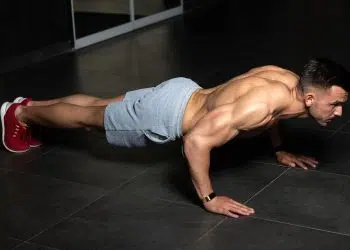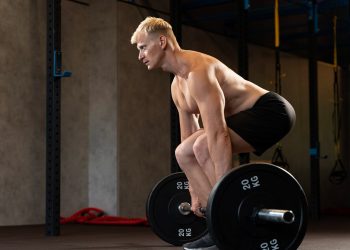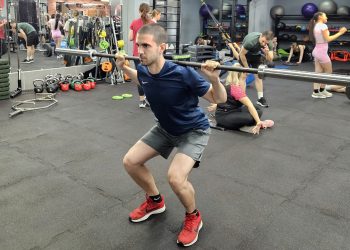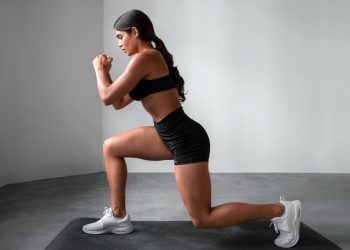The jump squat is a bodyweight calisthenics exercise that helps to improve lower body muscular development, explosive ability, and athleticism. You don’t need weights or equipment to do it, however, there are ways to make it more challenging and therefore more effective.
It’s not for everyone, especially those overweight or who suffer from joint pains but done right, the jump squat has many benefits.
Learn more about this movement including the muscles it trains, how to do it effectively, what the benefits are, and we’ve also included some variations and alternatives for workout variety and progress.
In This Exercise
- Target Muscle Group: Quadriceps
- Type: Strength, hypertrophy, athleticism
- Mechanics: Compound
- Equipment: N/A
- Difficulty: Beginner/intermediate
Muscles Worked
The jump squat involves several muscles which makes it an overall efficient activity. We’ve included brief descriptions of each one below.
Hamstrings
The hamstrings is a three-headed muscle group consisting of semitendinosus, semimembranosus, and biceps femoris.
This muscle group is located on the back of the upper leg opposite the quads and functions to extend the hips and flex the knees. It’s important to note that the short head of the biceps femoris only crosses the knee joint and not the hip like the other two muscles.
Level Up Your Fitness: Join our 💪 strong community in Fitness Volt Newsletter. Get daily inspiration, expert-backed workouts, nutrition tips, the latest in strength sports, and the support you need to reach your goals. Subscribe for free!
The hamstrings play an important role in standing but also explosive activities such as sprinting and jumping.
Additionally, this three-headed muscle is active during the gait cycle to resist knee extension, plus it stabilizes the knee joints and has other functions too.
Gluteus maximus
The butt is composed of a few different muscles such as the gluteus maximus, gluteus medius, and gluteus minimus.
The gluteus maximus forms most of the superficial appearance of the butt and hips and is a very important muscle for function and aesthetics. The jump squat engages this muscle primarily compared to the other glute muscles.
The butt primarily extends and externally rotates the thighs and it plays an important role in helping us to maintain an upright posture.
Quadriceps
The quadriceps or quads for short is the large group of muscles that make up most of your upper leg mass. It has four heads; rectus femoris, vastus lateralis, vastus medialis, and vastus intermedialis that help to flex the hips and extend the knees like during squats. These muscles are also important for posture, walking, and function of the spine and pelvis.
Adductor magnus
The adductor magnus is the largest of the muscles that make up the adductor group of muscles in the medial compartment of the thigh. While it assists during adduction of the thigh (limb moves toward center of the body), the adductor magnus also helps with hip extension and medial rotation. It has anterior and posterior fibers that help it act on the front and back of the leg.
Calves
The calves are the lower leg muscles consisting of the gastrocnemius and soleus. The gastrocnemius is the larger of the two and what most people think of when it comes to the calf muscles.
It’s the very visible muscle right below the knee that has two heads; medial and lateral and it gives the lower leg a lot of its shape. It joins with the soleus to form the Achilles tendon near the lower portion of the leg.
Then you have the soleus; a large muscle located deep to the gastrocnemius.
The calf muscles plantarflex (point the toes down) the foot and ankle. They are also important for posture, and athletic movements. Although they do have an uneven ratio of fast and slow-twitch fibers.
The gastrocnemius is composed of mostly fast-twitch fibers that make it better suited for quick and explosive movements. The soleus contains more slow-twitch fibers and is, therefore, better suited for endurance-type activities.
Core
The core group of muscles includes the abdominals, obliques, deep core muscles, and even the spinal erectors. These muscles contribute to trunk movement and spine stability. Jump squats involve the entire body and the core group of muscles play a role in stabilizing the trunk during this activity.
How To Do The Jump Squat
Because there’s a jumping component for the jump squat, beginners should be especially careful to remember a few key tips to ensure an effective and pain/injury-free experience. There’s definitely a wrong way to do this exercise. Here are step-by-step instructions for performing this movement.
- Stand up straight and keep your feet hip-width or slightly further apart but most importantly, choose a foot position that will allow you to squat and jump efficiently and comfortably.
- Keeping your back straight and chest up, squat down to about parallel and jump up so that your feet leave the ground. You should jump from your toes.
- Land on your toes and bend your knees to descend into another squat.
- Repeat for the desired number of reps.
Note: You can use your arms during this movement although there are different ways that people choose to involve their arms. The most basic and recommended for beginners is to do exactly as shown in the video. Bring your hand together in front of your chest and as you jump, extend your arms down and pretend you’re slicing the air. As you land, bring your hands back together in front of your chest.
Jump squat tips
- Do not perform this exercise if you’re overweight or suffer from joint pain.
- Avoid leaning too far forward as this places you in an awkward position that can cause a lot of strain on your lower back and it’s not proper form for this exercise.
- Make sure to bend your knees for a soft landing and to safely absorb the impact of the landing.
Benefits
Let’s talk about why you should do jump squats.
Level Up Your Fitness: Join our 💪 strong community in Fitness Volt Newsletter. Get daily inspiration, expert-backed workouts, nutrition tips, the latest in strength sports, and the support you need to reach your goals. Subscribe for free!
Build your leg muscles
This one is obvious. While regular bodyweight squats are great, jump squats add a power element that challenges the muscle fibers even more. Sprinters have great legs and it’s no doubt because of the impact and explosive element.
Improve explosiveness and athleticism
If you want to be athletic you have to do athletic activities. Jump squats involve a jump that includes triple joint extension – an essential component of training to be athletic. If you don’t use it you’ll lose it so if you like to be competitive and play sports this is a great choice that requires just your own body weight.
Burn fat and improve cardio fitness
Due to the total body involvement and impact, the jump squat will burn lots more calories than basic resistance-based exercises. Add it in your circuit training, HIIT and other workouts!
No equipment needed
The most convenient aspect of jump squats is that you don’t need any equipment or weights to do it. That’s why sports often include similar exercises.
Simple to make it more challenging
If you do want to make this exercise more challenging the good news is you can. By wearing a weighted vest, holding dumbbells or using a trap bar, there are so many different ways to make the jump squat more beneficial and useful for real world applications.
Check our top weight vest picks here.
Downsides
While there are downsides you can expect very few.
Not great for overweight or injury prone individuals
Similar to why running is not recommended for overweight or injury prone people, neither are jump squats. The impact on the joints is simply not worth it. There are many other great low to lower-impact options that are better. However, if you’re a larger athlete then that’s totally different.
Only so many ways to progress
Eventually your body will get accustomed to this exercise but especially if using just your body weight each time. You may have to do some variations to continue getting the benefits. Although, again, you can add more weight which will solve that problem.
Variations and Alternatives
The jump squat is an excellent exercise that’s tried and true. However, you may need something different whether to prevent boredom or increase the intensity. Try these variations and alternatives.
Weighted jump squat
We’ve mentioned this a few times previously but a great way to keep the gains coming is to add more weight. Do this by holding dumbbells or a kettlebell, using a trap or hex bar, wearing a weighted vest, or however you can do it safely and effectively.
Varied depth jump squats
Try to vary the depth of which you squat. This also has advantages in training you to be explosive at different angles. If you play sports you may have to overcome an external force in a variety of positions. Try a 1/4 depth squat jump or parallel and full depth variations.
Squat
If you want to train the same muscle groups then the basic squat (no jump) is no doubt of the best if not the best exercises for this. Squats work the entire lower body and the core and it’s superior for building strength. You could make the body weight squat harder by doing single-leg variations or doing it the traditional way with a loaded barbell or using any weights.
Step-up jumps
Step-up jumps are an underrated exercise especially when the goal is to build more muscle, strength and power. To do it you step up onto a bench or similar object and explode upward through that leg and then land on the opposite foot repeating the same movement and alternating legs.
Here’s a video example.
Kettlebell swing
If you want the explosive benefits unlike most of the other variations and alternatives, it doesn’t get better than the kettlebell swing. This exercise is popular among athletes and anyone looking to be more well-rounded. Not to mention, you’re using weight and can implement progressive overload. If you don’t have a kettlebell you can use a dumbbell or weight that will do the job.
How To Include Jump Squats Into Your Training
Jump squats are a versatile movement because you can do them whether you have access to equipment or not. In fact, many prefer to use only their body weight and that makes them great for calisthenics workouts.
Sometimes at the end of a resistance training session that includes the core lifts, you may want to perform a few sets of jump squats to finish off your legs and get that extra burn and stimulation.
There’s no perfect way to include this exercise but rather determine what your goals are and what you have access to. But most likely, you can add a few sets of jump squats to any workout and you won’t have to worry about overtraining.
If you’re a beginner, start slow and do a few sets of 8-10 and then increase this number every week to challenge yourself.
Get More Well-Rounded With Jump Squats
Jump squats have a lot going for them – they can build leg muscles, increase strength, power, and explosiveness and not to mention, they are super convenient. You can do them anywhere and become more well-rounded and athletic.
But if you wanted to make them harder you could as we explained that you have many options to increase the difficulty of the exercise.
Interested in measuring your progress? Check out our strength standards for Bodyweight Squat, Deadlift, Hip Extension, and more.











